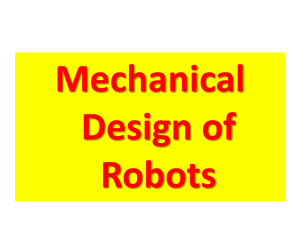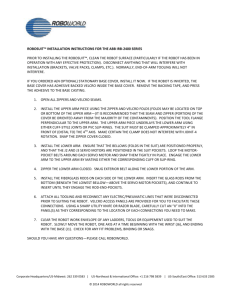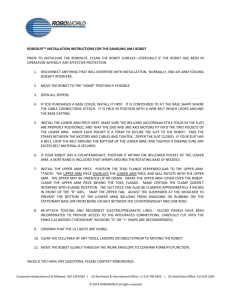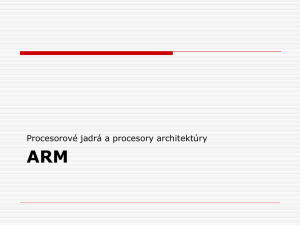Aihui Wang
advertisement
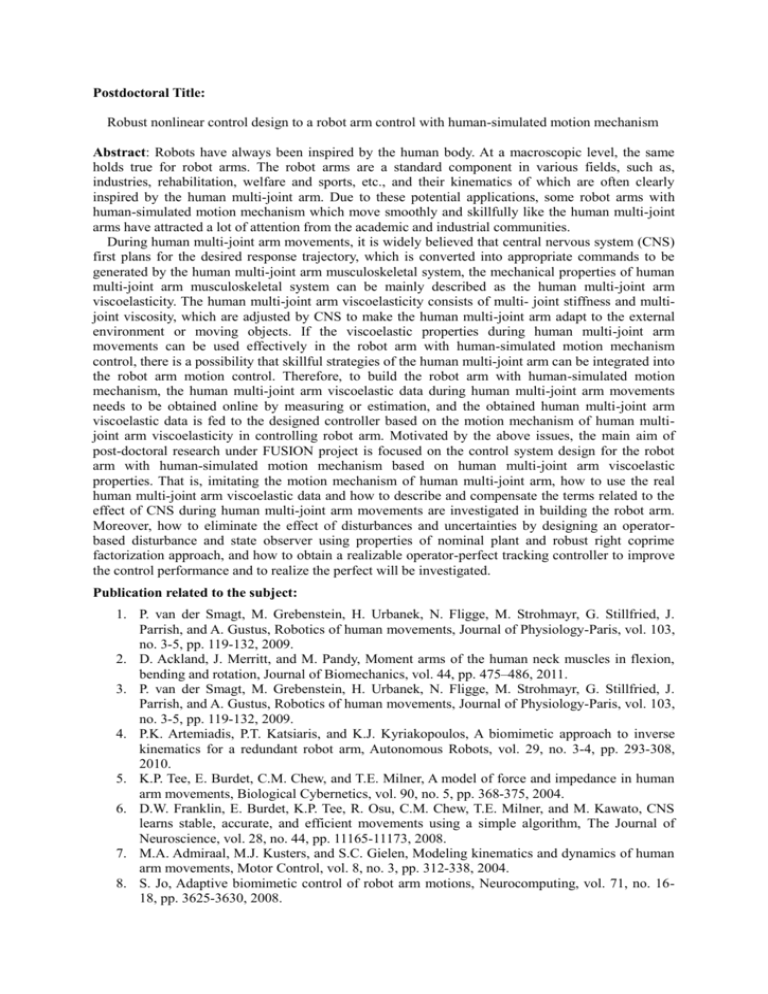
Postdoctoral Title: Robust nonlinear control design to a robot arm control with human-simulated motion mechanism Abstract: Robots have always been inspired by the human body. At a macroscopic level, the same holds true for robot arms. The robot arms are a standard component in various fields, such as, industries, rehabilitation, welfare and sports, etc., and their kinematics of which are often clearly inspired by the human multi-joint arm. Due to these potential applications, some robot arms with human-simulated motion mechanism which move smoothly and skillfully like the human multi-joint arms have attracted a lot of attention from the academic and industrial communities. During human multi-joint arm movements, it is widely believed that central nervous system (CNS) first plans for the desired response trajectory, which is converted into appropriate commands to be generated by the human multi-joint arm musculoskeletal system, the mechanical properties of human multi-joint arm musculoskeletal system can be mainly described as the human multi-joint arm viscoelasticity. The human multi-joint arm viscoelasticity consists of multi- joint stiffness and multijoint viscosity, which are adjusted by CNS to make the human multi-joint arm adapt to the external environment or moving objects. If the viscoelastic properties during human multi-joint arm movements can be used effectively in the robot arm with human-simulated motion mechanism control, there is a possibility that skillful strategies of the human multi-joint arm can be integrated into the robot arm motion control. Therefore, to build the robot arm with human-simulated motion mechanism, the human multi-joint arm viscoelastic data during human multi-joint arm movements needs to be obtained online by measuring or estimation, and the obtained human multi-joint arm viscoelastic data is fed to the designed controller based on the motion mechanism of human multijoint arm viscoelasticity in controlling robot arm. Motivated by the above issues, the main aim of post-doctoral research under FUSION project is focused on the control system design for the robot arm with human-simulated motion mechanism based on human multi-joint arm viscoelastic properties. That is, imitating the motion mechanism of human multi-joint arm, how to use the real human multi-joint arm viscoelastic data and how to describe and compensate the terms related to the effect of CNS during human multi-joint arm movements are investigated in building the robot arm. Moreover, how to eliminate the effect of disturbances and uncertainties by designing an operatorbased disturbance and state observer using properties of nominal plant and robust right coprime factorization approach, and how to obtain a realizable operator-perfect tracking controller to improve the control performance and to realize the perfect will be investigated. Publication related to the subject: 1. P. van der Smagt, M. Grebenstein, H. Urbanek, N. Fligge, M. Strohmayr, G. Stillfried, J. Parrish, and A. Gustus, Robotics of human movements, Journal of Physiology-Paris, vol. 103, no. 3-5, pp. 119-132, 2009. 2. D. Ackland, J. Merritt, and M. Pandy, Moment arms of the human neck muscles in flexion, bending and rotation, Journal of Biomechanics, vol. 44, pp. 475–486, 2011. 3. P. van der Smagt, M. Grebenstein, H. Urbanek, N. Fligge, M. Strohmayr, G. Stillfried, J. Parrish, and A. Gustus, Robotics of human movements, Journal of Physiology-Paris, vol. 103, no. 3-5, pp. 119-132, 2009. 4. P.K. Artemiadis, P.T. Katsiaris, and K.J. Kyriakopoulos, A biomimetic approach to inverse kinematics for a redundant robot arm, Autonomous Robots, vol. 29, no. 3-4, pp. 293-308, 2010. 5. K.P. Tee, E. Burdet, C.M. Chew, and T.E. Milner, A model of force and impedance in human arm movements, Biological Cybernetics, vol. 90, no. 5, pp. 368-375, 2004. 6. D.W. Franklin, E. Burdet, K.P. Tee, R. Osu, C.M. Chew, T.E. Milner, and M. Kawato, CNS learns stable, accurate, and efficient movements using a simple algorithm, The Journal of Neuroscience, vol. 28, no. 44, pp. 11165-11173, 2008. 7. M.A. Admiraal, M.J. Kusters, and S.C. Gielen, Modeling kinematics and dynamics of human arm movements, Motor Control, vol. 8, no. 3, pp. 312-338, 2004. 8. S. Jo, Adaptive biomimetic control of robot arm motions, Neurocomputing, vol. 71, no. 1618, pp. 3625-3630, 2008. 9. J. Izawa, T. Kondo, and K. Ito, Biological arm motion through reinforcement learning, Biological Cybernetics, vol. 91, no. 1, pp. 10-22, 2004. 10. F. Mussa-Ivaldi, N. Hogan, and E. Bizzi, Neural, mechanical, and geometric factors subserving arm posture in humans, The Journal of Neuroscience, vol. 5, no. 10, pp. 27322743, 1985. 11. R.C. Miall, D.J. Weir, D.M. Wolpert, and J.F. Stein, Is the Cerebellum a Smith Predictor?, Journal of Motor Behavior, vol. 25, no. 3, pp. 203-216, 1993. 12. D.W. Franklin, E. Burdet, R. Osu, M. Kawato, and T.E. Milner, Functional significance of stiffness in adaptation of multijoint arm movements to stable and unstable dynamics, Experimental Brain Research, vol. 151, no. 2, pp. 145-157, 2003. 13. E. Burdet, K.P. Tee, I. Mareels, T.E. Milner, C.M. Chew, D.W. Franklin, R. Osu, and M. Kawato, Stability and motor adaptation in human arm movements, Biological Cybernetics, vol. 94, no. 1, pp. 20-32, 2006. 14. J. Blouin, E. Guillaud, J.P. Bresciani, M. Guerraz, and M. Simoneau, Insights into the control of arm movement during body motion as revealed by EMG analyses, Brain Research, vol. 1309, pp. 40-52, 2010. 15. T. Tsuji and Y. Tanaka, Bio-mimetic impedance control of robotic manipulator or dynamic contact tasks, Robotics and Autonomous Systems, vol. 56, no. 4, pp. 306-316, 2008. 16. S.L. Hooper, Motor control: the importance of stiffness, Current Biology, vol. 16, no. 8, pp. R283-R285, 2006. 17. T. Bhattacharjee, Y. Oh, J.H. Bae, and S.R. Oh, Control design for human-like reaching movements using redundancy in robot arm-trunk systems, International Journal of Control Automation and Systems, vol. 9, no. 6, pp. 1173-1186, 2011. 18. M. Deng, A. Inoue, and K. Ishikawa, Operator-based nonlinear feedback control design using robust right coprime factorization, IEEE Transactions on Automatic Control, vol. 51, no. 4, pp. 645-648, 2006. 19. M. Deng, A. Inoue, and Q. Zhu, An integrated study procedure on real time estimation of time varying multijoint human arm viscoelasticity, Transactions of the Institute of Measurement and Control, vol. 33, no. 8, pp. 919-941, 2011.


